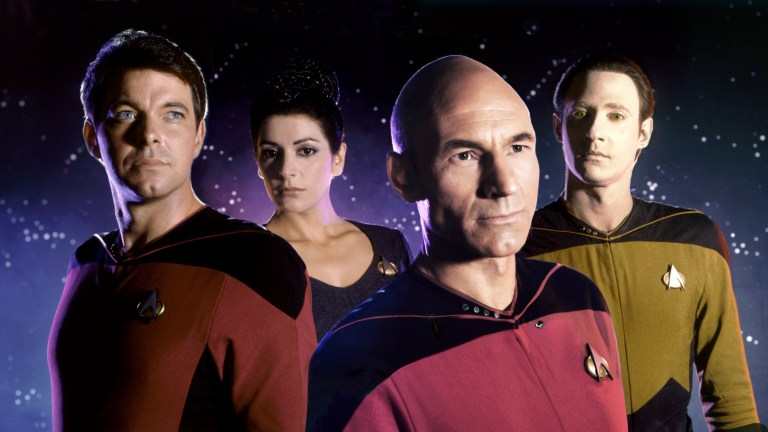Why Star Trek Uniform Colors Changed From the Original Series to Next Generation
The uniforms on Star Trek have changed over time, but for reasons that make a lot more sense behind the scenes than on the Enterprise bridge.

Even if you don’t know an El-Aurian from an Illyrian, even if you can’t tell the original Enterprise from the Enterprise-D, you’re probably familiar with one of the fundamental rules of Star Trek: redshirts always die.
Unlike many of the popular misconceptions about the series (Kirk doesn’t actually chase women, for example), the redshirt stereotype does have grounding in the show. Over the course of three seasons in The Original Series, 26 characters wearing red tunics died, as opposed to 15 wearing gold and blue combined. But that trend stopped with the Star Trek movies, and continued to fall away with The Next Generation and the spinoffs that followed.
Why, you ask? Because the costume colors signify a crewman’s role on their particular ship, and the color scheme changed between TOS and TNG.
Although some Trekkies hate to admit it, Star Trek didn’t really have much in the way of canon in its first few episodes. Leaving aside the infamous grinning Spock in the original pilot, it took several episodes to decide on the name of Starfleet or the Prime Directive. The same was true of the uniforms, as demonstrated by the luscious green shirt that Kirk sometimes sported.
By the end of the series, however, the three main colors solidified into the following divisions: those in command wore gold, people such as Kirk and Sulu. Science officers and doctors, namely Spock and Bones, dressed in blue, while everyone else had red shirts. And by everyone else, that includes engineers like Scotty and security personnel, which is why they tended to get killed.
But as is so often the case with all things Trek, the uniforms weren’t entirely what creator Gene Roddenberry had in mind. Most notably, the gold uniforms were actually intended to be green, but read on camera as the color that we know today. During production of the never-released follow-up show, Star Trek: Phase II, Roddenberry wanted continuity between TOS and the new series, not only in terms of the cast, which mixed Kirk and Sulu with newcomers, but also production. In particular, Roddenberry brought back his original series costume designer William Ware Theiss.
However, when production shifted and Phase II became Star Trek: The Motion Picture, Theiss was replaced by Robert Fletcher, who designed costumes for the movie crew through Star Trek IV: The Voyage Home. Fletcher maintained some of Roddenberry’s vision for TMP, which tried to match ’70s aesthetics by giving the crew pastel pajamas. But when Nicholas Meyer took over for Star Trek II: The Wrath of Khan, Fletcher designed military-inspired uniforms to match the director’s naval warfare vision.
Although most Trekkies prefer the Meyer movies, Roddenberry hated the militarization of Starfleet and, equally important, resented the way his franchise was taken from him. So when Roddenberry regained some power for The Next Generation, he sought to right the ship, so to speak, by making Starfleet explorers again. And with it, he brought back Theiss.
For the most part, Theiss succeeded where Roddenberry and Fletcher failed in TMP. The TNG uniforms feel like ’80s versions of the ’60s original, especially after they were revised in season 3. However, with the emphasis on division colors came a confusing switch. Once again, science officers and doctors wore blue, but command now wore red while operations wore gold. Also, there’s the skant, but only Lower Decks talks about that now.
So why did the colors change? Once again, the answer is simple and almost mundane. Patrick Stewart apparently didn’t look commanding enough in yellow, while Brent Spiner, in his pale Data makeup, didn’t look good in red.
Roddenberry and the producers may have also been amenable to these changes because of the public’s changing perception of the aesthetic of Star Trek at the time. It was the massive success of Star Trek IV that gave Roddenberry the green light for TNG, and in that movie the crew wore the same civilian clothes that they sported in The Search for Spock, but during the first three Trek movies, Kirk wore red (as did Spock and the rest of the crew, because everyone wore red in Meyers’ more militarized uniforms).
So in the eyes of casual fans, the Captain wore red. And even Trekkies had seen enough of Kirk in red that the idea didn’t seem outlandish.
The Trek uniforms have been altered many times since. TNG and Deep Space Nine later limited colors to the shoulders, a look continued in Voyager. The TNG movies then introduced darker uniforms in Star Trek: First Contact, with division colors on the underliner, a look adopted by later seasons of Deep Space Nine.
These stories adhere to the division colors from TNG, but whenever the franchise goes back to pre-TNG era — including the J.J. Abrams reboot movies or Strange New Worlds — the TOS colors come back into play. Even the prequel series Enterprise, in which the crew of the NX-01 wears blue jumpsuits with TOS division colors on the piping. And then there’s Discovery, which began with blue uniforms and a different division color scheme, but that show started out as its own thing, anyway.
Rest assured, writers both official and on the internet have offered in-Universe explanations for the evolution of the costumes. But the best explanation is that Star Trek, as an ongoing story over six decades old, had evolved and mutated over the years, sometimes in ways that don’t make sense. And as long as some unnamed operations ensign gets killed now and again, that’s just fine.
